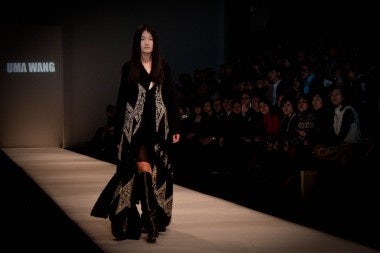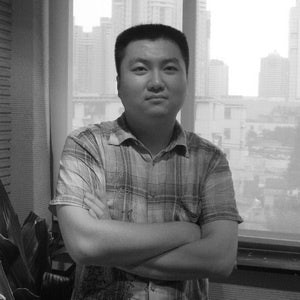Yi Qizheng, Fashion Trend Digest Editor, Weighs In On How Shanghai Fashion Week Can Improve#

Designer Uma Wang's 2010 runway show: Is Shanghai Fashion Week becoming more inwardly focused?
From March 16-18, Shanghai Fashion Week will run alongside Mode Shanghai for the first time at the Shanghai Expo Center, joining a number of high-profile runway events with a larger trade show. Recently, BundPic spoke to Fashion Trend Digest editor Ye Qizheng (叶琪峥) about how Shanghai Fashion Week stacks up to other Fashion Weeks around the world, and asked what could take it to the next level. From BundPic (translation by Jing Daily team):
BundPic (BP): In the middle of this month, the Fall Winter 2011 Shanghai Fashion Week will be held alongside Mode Shanghai 2011. What type of show is Mode Shanghai? What does this mean for Shanghai Fashion Week?#
Ye Qizheng (YQZ)#
: Mode Shanghai, which was organized second, is a fashion trade show that connects retailers, and is, in fact, not for consumers. It is like the Pret a Porter Paris Exhibition of women's clothing, the Pitti Uomo show in Florence and the US Men's Magic Show in Las Vegas. Holding Mode Shanghai and the Shanghai Fashion Week at the same time can allow the pooling of resources. Whether it is for the participating brands, retailers who have come for business opportunities, or media who’s covering the event, everyone stands to gain during this short period of time.
BP#
:
In accordance with international standards, Shanghai Fashion Week is held twice a year. But the form, content and scale of the Spring/Summer and Fall/Winter fashion weeks greatly differ, and they have no fixed location. Why is that?#
YQZ#
: There is actually a historical reason. Shanghai Fashion Week being held twice a year is a recent development. In 2003, Shanghai Fashion Week began to be held as a separate event in the latter half of the year, while the Shanghai International Fashion Culture Festival was held in the first half. The Shanghai International Fashion Culture Festival has been held for nearly twenty years, so you can imagine that in the 90s, it was a popular fashion event, and it also included a fashion forum, a design competition and other related activities.
Therefore, in the last few years, the Shanghai Fashion Week held in the first part of the year was usually at a newly built Creative Park in collaboration with the Shanghai International Fashion Culture Festival, while the second Shanghai Fashion Week was held in basic fixed tents at Fuxing Park.
This time, with Mode Shanghai and Shanghai Fashion Week held at the same time, most important is that the sponsored activities are well organized. The time and place of future activities will gradually be fixed.
BP: When and where did you first participate in Shanghai Fashion Week? Which season left the deepest impression on you?#
YQZ#
: The first time I participated in Shanghai Fashion Week was in October 2003 at Riverside Avenue in Pudong, with a lot of big-name shows, including Ferragamo, Lanvin, Vivienne Westwood and so on. In subsequent years, Shanghai Fashion Week also had shows from brands like Nina Ricci, Karl Lagerfeld and Jean Paul Gaultier, among others. In 2006, the French High Fashion Association brought six cutting-edge designers, and that season also had British designer Julien MacDonald, Unconditional, and India’s Manish Arora.
But I was most impressed by the Fall/Winter 2009 Shanghai Fashion Week because under the support of the organizing committee, many local young designers were able to participate.
As for the show with the most viewers, that should be last year's Ann-Sofie Back show. There were so many people in the end, that the audience was sitting on the floor in front of the first row, making the front row seats into the second row.

Fashion editor Ye Qizheng (叶琪峥)
BP: Based on your experience participating in Shanghai Fashion Week, what has seen success or failure, and what do you think needs improvement?#
YQZ#
: Early on, Shanghai Fashion Week invited many big name labels to show in Shanghai and this attracted a lot of attention, but this approach is not sustainable. If the big brands want to promote themselves, they do not have to participate in Shanghai Fashion Week. Holding their own separate event might work even better. Therefore, with the absence of big labels in recent years, Shanghai Fashion Week’s overall appeal was affected.
While this is somewhat further down the road, major cities around the world essentially have their own fashion weeks, but most of them consist of local activities. A truly sustainable and influential fashion week must be a fashion week that is able to create shows for brands that bring business, otherwise it would be difficult for a brand to commit long-term to participating in a city. Because if it were only for media promotion, the brand could choose various cities in order to appeal to the largest audience.
For example, Los Angeles Fashion Week, after struggling for several years, finally had to close. Logically, Los Angeles is the major city on the West Coast and the organizers, the IMG Group had both the experience and the power, but local LA fashion brands weren’t enthusiastic and would rather participate in New York Fashion Week, so ultimately sponsors stopped investing and it ended. Comparatively, IMG organized Miami Swimwear Fashion Week, and although it's small, it's quite popular.
BP: In your opinion, which of the major international Fashion Weeks model and experience should Shanghai Fashion Week learn from?#
YQZ#
: The four major fashion weeks, Paris, Milan, London and New York are each different. You cannot surpass Paris, and Milan has the big brands. The brands who participate in these two fashion weeks are very important, to the extent that the menswear and womenswear are organized a month apart. While London brings together cutting-edge avant-garde designers, London Fashion Week has the smallest influence of the four. One common feature of Paris, Milan and London are that the shows are export-oriented to allow retailers from all over the world to place orders. Comparatively, New York Fashion Week is more geared towards the U.S. domestic market, which is similar to the situation in China. New York Fashion Week has the largest number of brands participating, naturally, because the United States has a large domestic market.
Recently, there has been rapid growth in retail sales and domestic consumption [in China], so Shanghai Fashion Week should help aid this trend. Whether it is foreign brands entering China, or local brands hoping to expand in the domestic market, there needs to be a cost-effective platform. Therefore, I think Shanghai Fashion Week stands to learn from the New York Fashion Week model.
To become an influential international fashion week, having a fixed time is very important. Before the start of this year’s Fall/Winter womenswear shows in Paris, the dates for next year’s Paris Fashion Week is already set. The fashion industry has a specific work cycle, and a set date will allow associated brands, retailers, and media to place the event into their schedules. For example, U.S. Vogue’s Editor in Chief, Anna Wintour, missed part of Milan Fashion Week due to the Oscars, and whatever brand scheduled their show for that day certainly missed having here there.
Right now, the timing of the four major fashion weeks is the result of a back-and-forth. London Fashion Week received pressure from New York and Milan, putting its time ahead of New York Fashion Week, but the arrangement is actually inconvenient, to have to go to the UK and then New York before returning to Europe, and this may cause people to give up going to London Fashion Week. So, ultimately, there’s no gain.
The current timing is New York, London, Milan and Paris Fashion Weeks running for a month between February 9 to March 9, and other fashion weeks can only be arranged before or after, such as Berlin, Copenhagen and Stockholm, who arranged to run from the end of January to early February, in which Copenhagen and Stockholm was placed in the beginning and end to facilitate those who wanted to participate in both.
BP: You wrote an article comparing Shanghai and Beijing’s Fashion Weeks, the former described as "bringing in," and the latter "pushing out." In the long run, which city’s influence will be greater? Which city has more potential to become a "fashion capital”?#
YQZ#
: In the long term, who is more influential will depend on the position and effort, whoever can bring brands business and reputation will become more influential. As to which city has more potential to become a "fashion capital,” it’s not easy to say, as brands are concentrated in Shanghai while the media is concentrated in Beijing. Fendi was at the Great Wall of China in Beijing, Chanel was in Shanghai, Prada at the Central Academy of Fine Arts in Beijing, Chloe at the Shanghai Expo Center. Maybe Shanghai and Beijing will become a tale of two cities!
BP: When this season’s Mode Shanghai and Shanghai Fashion Week joined forces, they set a three-year goal to establish a “global fashion brand business center.” To really achieve this goal, what does this mean for consumers and those in the fashion industry?#
YQZ#
: If China's consumption growth can be sustained and grow rapidly, the external conditions to achieve this goal will be there, and the key will be to see how it is implemented. If realized, the fashion industry will have a better platform to communicate with more brands and retailers, and consumers will be able to purchase more overseas brands and cutting-edge brands more quickly.